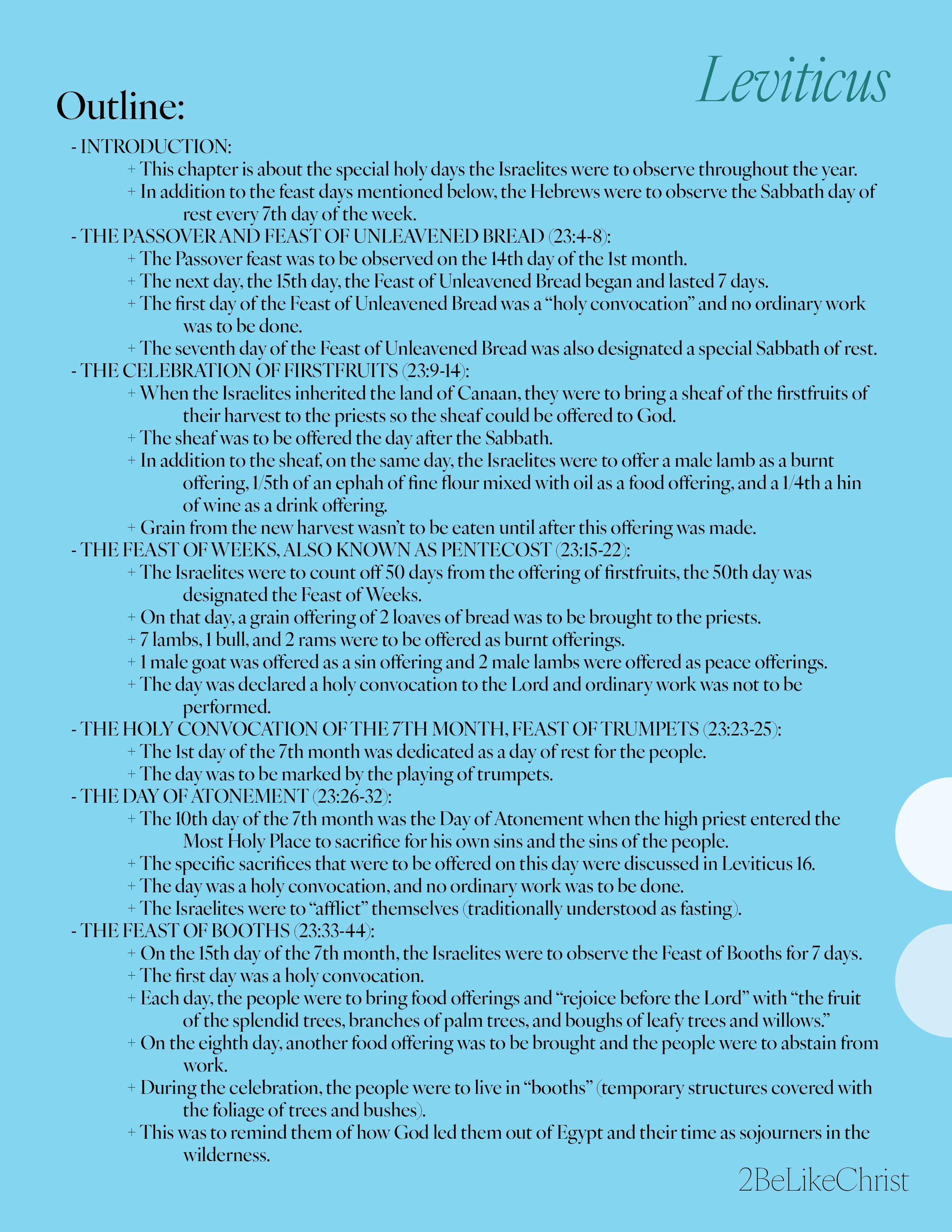Leviticus 23 Summary: A Short Breakdown in 5 Minutes
Leviticus 23 Summary - A Quick Overview
WHEN:
Leviticus picks up where Exodus left off. The children of Israel are on their way through the wilderness to the Canaan land.
According to Leviticus 8, the Tabernacle had already been erected, which would place the year at approximately 1490 B.C. (one year after the Israelites left Egypt).
DEFINITIONS:
Sheaf – A bundle of grain stalks that have been tied together.
Ephah – A unit of measure used for grain, approximately 22 liters.
Hin – A unit of measure for liquids, approximately 3.7 liters (.98 gallons).
Convocation – A formal assembly of a large group of people.
TABERNACLE DIAGRAM
OUTLINE:
INTRODUCTION:
This chapter is about the special holy days the Israelites were to observe throughout the year.
In addition to the feast days mentioned below, the Hebrews were to observe the Sabbath day of rest every 7th day of the week.
THE PASSOVER AND FEAST OF UNLEAVENED BREAD (23:4-8):
The Passover feast was to be observed on the 14th day of the 1st month.
The next day, the 15th day, the Feast of Unleavened Bread began and lasted 7 days.
The first day of the Feast of Unleavened Bread was a “holy convocation” and no ordinary work was to be done.
The seventh day of the Feast of Unleavened Bread was also designated as a day of holy convocation.
THE CELEBRATION OF FIRSTFRUITS (23:9-14):
When the Israelites inherited the land of Canaan, they were to bring a sheaf of the firstfruits of their harvest to the priests so the sheaf could be offered to God.
The sheaf was to be offered the day after the Sabbath.
In addition to the sheaf, on the same day, the Israelites were to offer a male lamb as a burnt offering, 1/5th of an ephah of fine flour mixed with oil as a food offering, and a 1/4th a hin of wine as a drink offering.
Grain from the new harvest wasn’t to be eaten until after this offering was made.
THE FEAST OF WEEKS, ALSO KNOWN AS PENTECOST (23:15-22):
The Israelites were to count off 50 days from the offering of firstfruits, the 50th day was designated the Feast of Weeks.
On that day, a grain offering of 2 loaves of bread was to be brought to the priests.
7 lambs, 1 bull, and 2 rams were to be offered as burnt offerings.
1 male goat was offered as a sin offering and 2 male lambs were offered as peace offerings.
The day was declared a holy convocation to the Lord and ordinary work was not to be performed.
THE HOLY CONVOCATION OF THE 7TH MONTH, FEAST OF TRUMPETS (23:23-25):
The 1st day of the 7th month was dedicated as a day of rest for the people.
The day was to be marked by the playing of trumpets.
THE DAY OF ATONEMENT (23:26-32):
The 10th day of the 7th month was the Day of Atonement when the high priest entered the Most Holy Place to sacrifice for his own sins and the sins of the people.
The specific sacrifices that were to be offered on this day were discussed in Leviticus 16.
The day was a holy convocation, and no ordinary work was to be done.
The Israelites were to “afflict” themselves (traditionally understood as fasting).
THE FEAST OF BOOTHS (23:33-44):
On the 15th day of the 7th month, the Israelites were to observe the Feast of Booths for 7 days.
The first day was a holy convocation.
Each day, the people were to bring food offerings and “rejoice before the Lord” with “the fruit of the splendid trees, branches of palm trees, and boughs of leafy trees and willows” (23:40).
On the eighth day, another food offering was to be brought and the people were to abstain from work.
During the celebration, the people were to live in “booths” (temporary structures covered with the foliage of trees and bushes).
This was to remind them of how God led them out of Egypt and their time as sojourners in the wilderness.
APPLICATION:
For the sake of clarity, I want to use our application section to outline these feast days as concisely as possible:
1st month, 14th day – Passover
1st month, 15th day and lasting 7 days – Feast of Unleavened Bread.
1st month, 16th day – Celebration of Firstfruits (the exact day is debated).
50 days after Firstfruits – Pentecost (Feast of Weeks).
7th month, 1st day – Holy convocation of the 7th month (sometimes called the Feast of Trumpets).
7th month, 10th day – Day of Atonement
7th month, 15th day and lasting 8 days – Feast of Booths and a day of holy convocation on the eight day (sometimes called the Feast of Tabernacles).


